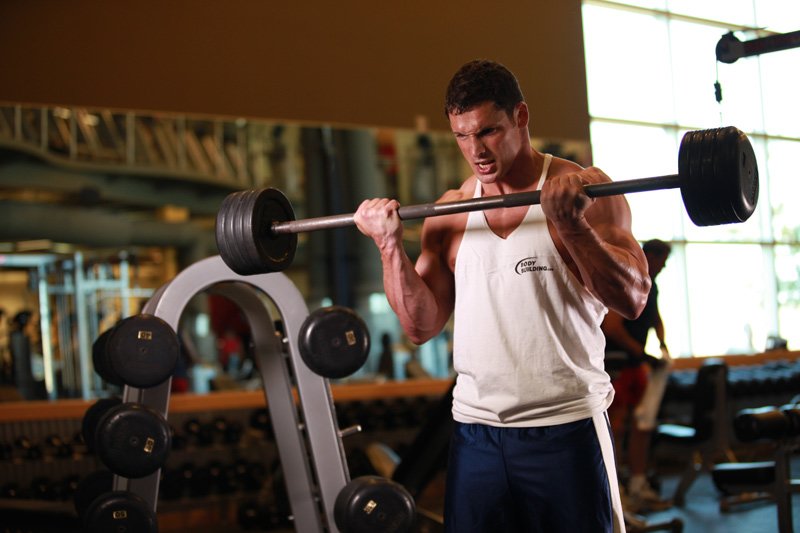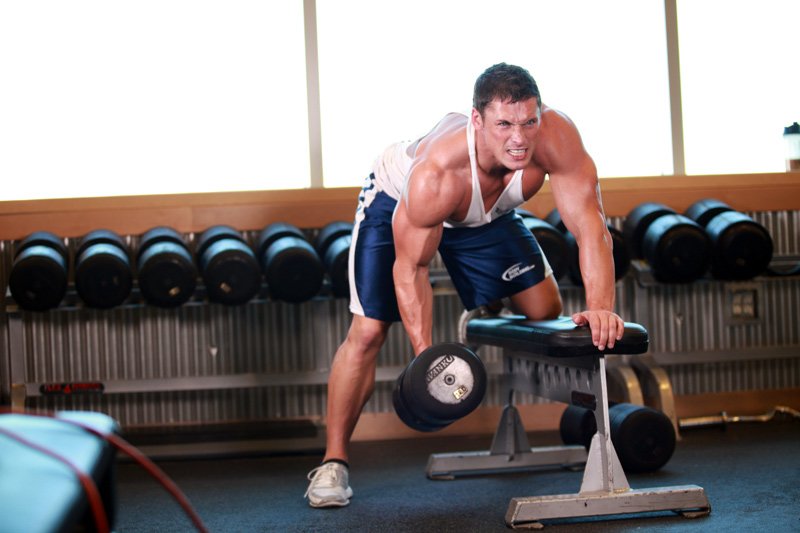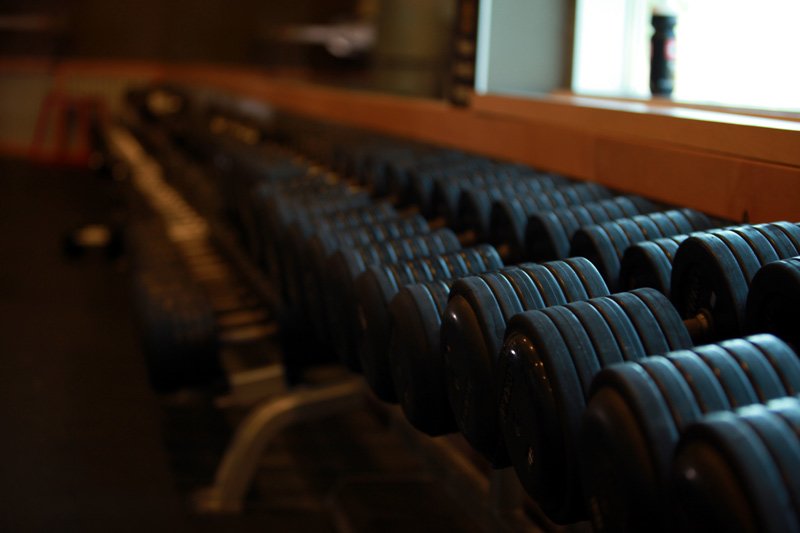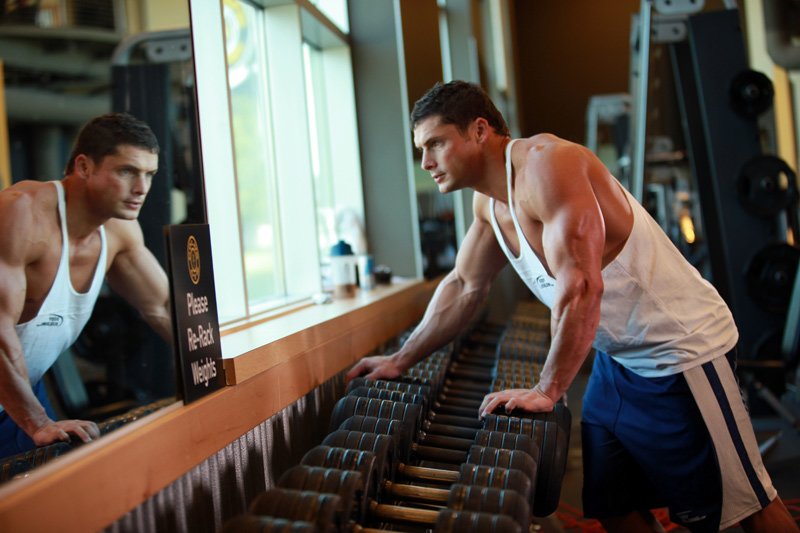So you want to gain muscle? There are many different programs and methods of training out there that are going to accomplish muscle growth. Add to that the fact that each individual is unique and that what may work for one in acquiring muscle mass may not work for another.
There are, however, general standards and principles that most 'mass gaining' training programs are based upon; and whilst many use traditional methods of training for hypertrophy, there are other ways to achieve the same, if not better, results.
This article will discuss the different types of muscle fibers, the physiology of muscle growth, training parameters that work best for hypertrophy, and provide a sample program for muscle building.

Muscle Fibers And Types
Slow Oxidative Fibers
Slow oxidative fibers are commonly referred to as Type I muscle fibers. These muscle fibers are recruited first during activity, contracting slowly due to slow Myosin ATPase activity.
Although Type I fibers have a high Myoglobin content, they contain low glycogen levels, using aerobic glycolysis for Adenosine Triphosphate (ATP) (i.e. energy) synthesis.
Myoglobin
Myoglobin is a single-chain globular protein of 153 or 154 amino acids, containing a haem (iron-containing porphyrin) prosthetic group in the center around which the remaining apoprotein folds. It has eight alpha helices and a hydrophobic core.
A high oxidative capacity, due to the many capillaries and mitochondria that they contain, allows them to have a slow rate of fatigue, therefore making them best suited for endurance activities such as distance running (Marieb, 2004).
Fast Oxidative Fibers
Fast oxidative fibers, also called Type IIa muscle fibers, are recruited second during exercise. Like Type I fibers Type IIa fibers have high Myoglobin content and many capillaries and mitochondria.
However, instead of low glycogen stores their glycogen content is moderate, causing them to be moderately fatigue resistant. Alongside this, they have fast contractile speeds and Myosin ATPase activity, therefore making them best suited for activities that use both the anaerobic glycolysis and aerobic glycolysis energy systems, such as sprinting (Marieb, 2004).

Fast Glycolytic Fibers
Fast glycolytic fibers, the Type IIb muscle fibers, do not use oxygen for fuel, and are recruited third during activity. Type IIb fibers have few capillaries and mitochondria and low Myoglobin content.
Although Type IIb fibers depend entirely on glycogen for fuel, despite having high glycogen stores, they fatigue quickly. This coupled with their powerful contractile ability and fast Myosin ATPase activity make them best suited for short-term intense or powerful movements, such as used in resistance training (Marieb, 2004).

Physiology Of Muscle Growth
When muscles are used they adapt and change. Changes are dependent on the type of activity and muscle fiber types used, the load exerted on the muscle, and the velocity and duration of the contraction (Marieb, 2004).
Muscle growth, also referred to as muscle hypertrophy, is an example of muscular adaptations and changes.
Muscle hypertrophy occurs primarily through chronic anaerobic, high-intensity resistance activity, like that which happens during resistance training lifting weights (Brown, McCartney & Sale, 1990; Cureton, Collins, Hill, & McElhannon, 1988; Marieb, 2004; McCall, Byrnes, Dickenson, Pattany, & Fleck, 1996).
Resistance training causes neural adaptations, which result in changes in muscular endurance and muscular strength, and eventually, the size of the muscles (Fleck & Kraemer, 2004).
Resistance training causes an increase in the cross-sectional area (CSA) of all muscle fiber types (Brown, et al. 1990; Cureton, et al. 1988; Holm, et al. 1991; McCall, et al. 1996; Widrick, Stelzer, Shoepe & Garner, 2002), without an increase in muscle fiber numbers (McCall, et al. 1996).
Age and sex have been shown to influence the degree to which hypertrophy occurs in an individual (Martel, et al. 2005).
Training Parameters
Type Of Exercise
Anaerobic, high-intensity resistance training (Brown, et al. 1990; Cureton, et al. 1988; Marieb, 2004; McCall, et al. 1996) is the best exercise stimulus for muscle growth.

Training Splits
Depending on the training status of trainee will determine their training splits. For example, a beginner or novice to resistance training would be best served with 2-3 resistance training sessions a week, working the full body each session, as working the full body produces more anabolic hormone than just doing the upper or lower body alone (Heyward, 2006).
Although the more muscle fibers activated during a session the better hypertrophy occurs, for the experienced or veteran trainee 3-6 day body-part splits would be recommended, as they need something more than 2-3 sessions a week or just full-body to stimulate further muscle growth, and can better adapt their training sessions for higher muscle recruitment and focus on a specific muscle or muscle groups.
Resistance Training Exercises
Exercises that build muscle the best are compound, multijoint exercises, as they recruit more of the body to perform the exercise (Heyward, 2006) and thus recruit and activate more muscle fibers (Charlebois, 2007).
The best compound exercises for hypertrophy are the squat and the deadlift, as they use pretty much every muscle in your body (Baechle, Earle & Wathen, 2000). Other compound exercises that are good to include are the bench press, shoulder press, pull-ups, and dips.
Mode Of Weights
Those wanting to gain muscle mass use a variety of both free weights and machine to achieve hypertrophy.
Although it does not matter how the load is placed on the muscle for muscle growth, research has shown that free weights such as barbells and dumbbells are superior to machine weights in muscle recruitment and activation, as they require more muscles to be used for any given exercise (McCaw & Friday, 1994).

Intensity And Volume
For those wanting to improve their muscular endurance alongside muscle gains, it is traditionally recommended to use low to moderate intensity (50-75% 1RM) with a very moderate volume (3-6 sets of 10-20 reps, with 8-12 reps being the hypertrophy range) (Charlebois, 2007; Wathen, Baechle & Earle, 2000).
However, muscle growth is best achieved using heavy load resistance training of at least 70% 1RM (Holm, et al., 2008); and for those wanting to gains muscular strength as well as muscle mass, then high intensity (at least 70% 1RM), high volume (whether they be low or high rep, as long as they are high volume) training programs work extremely effectively to achieve this (Charlebois, 2007; Holm, et al., 2008).
Exercise Velocity
Although both fast and low velocity resistance training increases muscle CSA of all muscle fiber types, fast velocity training induces greater development of the muscle, especially in Type IIa and Type IIb muscle fibers (Shepstone, et al., 2005).

Progressive Overload
Progressive overload must continually occur in order to induce adaptations and changes resulting in muscular hypertrophy.
Progressive overload can be achieved through several methods, including increasing the intensity of exercise or resistance/weight used while staying with the same set and rep range, increasing the volume by increasing the number of sets and/or reps at the same or higher weight, changing tempo and training velocity, rest periods, etc. (Fleck & Kraemer, 2004).
Sample Training Program
Training programs such as the 5x5 or 6x6 work well for muscle growth, all of which are high intensity, high volume regimens. The 10x3 training program, created by Derek "Beast" Charlebois (2007), is of a similar nature, with mass and strength results achieved.
For more information on the principles behind the 10x3 Training program, read The Power to be Pretty: Training for Strength and Lean Mass (Charlebois, 2007).
The following 10x3 training program is an adaptation of the original program. Recommended only for experienced and more advanced lifters, it is a 6-day a week program, and completed for 12 weeks requires dedication and sacrifice, but is well worth it in the end.
Monday
- Cardio: 30 minute of low to moderate intensity in the morning
- Crunches: 3 sets of 8-12 reps
- Hanging Leg Raises: 3 sets of 8-12 reps
- Ab Crunch Machine: 3 sets of 8-12 reps
- Barbell Squats: 10 sets of 3 reps (2-3 minutes rest between sets)
- Cardio: 30 minute of low to moderate intensity post-workout
Tuesday
- Cardio: 30 minute of low to moderate intensity in the morning
- Barbell Squats: 3 sets of 8-12 reps (1-2 minutes rest between sets)
- Leg Press: 3 sets of 8-12 reps (1-2 minutes rest between sets)
- Leg Extensions: 3 sets of 8-12 reps (1-2 minutes rest between sets)
- Dumbbell Lunges: 3 sets of 8-12 reps (1-2 minutes rest between sets)
- Wrist Curls: 3 sets of 8-12 reps (1-2 minutes rest between sets)
- Seated Calf Raises: 3 sets of 8-12 reps (1-2 minutes rest between sets)
Wednesday
- Cardio: 30 minute of low to moderate intensity in the morning
- Bench Press: 10 sets of 3 reps (2 second pause at bottom, 2-3 minutes of rest)
- Crunches: 3 sets of 8-12 reps
- Hanging Leg Raises: 3 sets of 8-12 reps
- Ab Crunch Machine: 3 sets of 8-12 reps
- Cardio: 30 minute of low to moderate intensity post-workout
Thursday
- Cardio: 30 minute of low to moderate intensity in the morning
- Bench Press: 3 sets of 8-12 reps (1-2 minutes rest between sets)
- Military Press: 3 sets of 8-12 reps (1-2 minutes rest between sets)
- Barbell Shrugs: 3 sets of 8-12 reps (1-2 minutes rest between sets)
- Push-ups: 3 sets of 8-12 reps (1-2 minutes rest between sets)
- Close-Grip Bench Press: 3 sets of 8-12 reps (1-2 minutes rest between sets)
- Dips: 3 sets of 8-12 reps (3 second pause at bottom, 1-2 minutes rest between sets)
- Triceps Push-downs: 3 sets of 8-12 reps (1-2 minutes rest between sets)
- Wrist Curls: 3 sets of 8-12 reps (1-2 minutes rest between sets)
- Seated Calf Raises: 3 sets of 8-12 reps (1-2 minutes rest between sets)
Friday
- Cardio: 30 minute of low to moderate intensity in the morning
- Crunches: 3 sets of 8-12 reps
- Hanging Leg Raises: 3 sets of 8-12 reps
- Ab Crunch Machine: 3 sets of 8-12 reps
- Barbell Deadlift: 10 sets of 3 reps (2 second pause at bottom, 2-3 minutes rest)
- Cardio: 30 minute of low to moderate intensity post-workout
Saturday
- Cardio: 30 minute of low to moderate intensity in the morning
- Barbell Deadlift: 3 sets of 8-12 reps (1-2 minutes rest between sets)
- Pullups: 3 sets of 8-12 reps (1-2 minutes rest between sets)
- Lat Pull-downs: 3 sets of 8-12 reps (1-2 minutes rest between sets)
- Bent-Over Barbell Rows: 3 sets of 8-12 reps (1-2 minutes rest between sets)
- Seated Cable Rows: 3 sets of 8-12 reps (1-2 minutes rest between sets)
- Barbell Curls: 3 sets of 8-12 reps (1-2 minutes rest between sets)
- Hammer Curls: 3 sets of 8-12 reps (1-2 minutes rest between sets)
- Reverse Curls: 3 sets of 8-12 reps (1-2 minutes rest between sets)
- Lying Leg Curls: 3 sets of 8-12 reps (1-2 minutes rest between sets)
- Wrist Curls: 3 sets of 8-12 reps (1-2 minutes rest between sets)
- Seated Calf Raises: 3 sets of 8-12 reps (1-2 minutes rest between sets)
Sunday
- Day off (if you want to do something active, do no more than 30 minutes of low to moderate intensity cardio)
Conclusion
There are three different muscle fiber types in the body: Type I, Type IIa, and Type IIb. The best type of activity for inducing muscular hypertrophy is resistance training. Factors such as age, sex and training status all affect and influence the degree to which hypertrophy occurs in an individual.
However, training parameters can be manipulated in the pursuit of muscle growth, including training splits, exercises, weight mode, intensity and volume of exercise, and training velocity, with the best hypertrophy regimes being high intensity, high volume, using compound exercises at a fast velocity that employ progressive overload over the program period. Through this, resistance training increases the CSA of all muscle fiber types.
Be aware that training is not all one must do to gain muscle. Nutrition is also highly important, and without the correct manipulation of diet toward hypertrophy, one can train as hard and as long as they want and still not get results.
References:
- Baechle, T. R., Earle, R. W. & Wathen, D. (2000). Resistance Training. In T. R. Baechle & R. W. Earle (Eds.). Essentials of strength training and conditioning (2nd ed.) (p. 395-421). Hong Kong: Human Kinetics.
- Brown, A. B., McCartney, N. & Sale, D. G. (1990). Positive adaptations to weight-lifting training in the elderly. J. Appl. Physiol, 69, 1725-1733.
- Charlebois, D. (2007). The power to be pretty: Training for strength and lean mass. Retrieved August 31, 2009, from https://www.bodybuilding.com/fun/beast54.htm.
- Cureton, K. J., Collins, M.A., Hill, D. W. & McElhannon, F. M. (1988). Muscle hypertrophy in men and women. Med. Sci. Sports Exercise, 20, 338-344.
- Fleck, S. J. & Kraemer, W. J. (2004). Designing Resistance Training Programs (3rd ed.). Champaign, Illinois, USA: Human Kinetics.
- Heyward, V. H. (2006). Advanced fitness assessment and exercise prescription (5th ed.). United States of America: Human Kinetics.
- Holm, L., Reitelseder, S., Pedersen, T. G., Doessing, S., Petersen, S. G., Flyvbjerg, A., Andersen, J. L., Aagaard, P. & Kjaer, M. (2008). Changes in muscle size and MHC composition in response to resistance exercise with heavy and light loading intensity. J Appl Physiol, 105, 1454-1461.
- Marieb, E. N. (2004). Human anatomy & physiology (6th ed.). San Francisco, CA, USA: Pearson Benjamin Cummings.
- Martel, G. F., Roth, S. M., Ivey, F. M., Lemmer, J. T., Tracy, B. L., Hurlbut, D. E., Metter, E. J., Hurley, B. F. & Rogers, M. A. (2005). Age and sex affect human muscle fiber adaptations to heavy-resistance strength training. Exp Physiol, 2,457-464.
- McCall, G. E., Byrnes, W. C., Dickenson, A., Pattany, P. M. & Fleck, S. J. (1996). Muscle fiber hypertrophy, hyperplasia, and capillary density in college men after resistance training. J. Appl. Physiol. 81(5): 2004-2012.
- McCaw, S. T. & Friday, J. J. (1994). A comparison of muscle activity between a free weight and machine bench press. Journal of Strength and Conditioning Research, 8(4), 259-264.
- Shepstone, T. M., Tang, J. E., Dallaire, S., Scheunke, M. D., Staron, R. S. & Phillips, S. M. (2005). Short-term high- vs. low-velocity isokinetic lengthening training results in greater hypertrophy of the elbow flexors in young men. J Appl Physiol, 98, 1768-1776.
- Wathen, D., Baechle, T. R. & Earle, R. W. (2000). Training variation: Periodization. In T. R. Baechle & R. W. Earle (Eds.). Essentials of strength training and conditioning (2nd ed.) (p. 395-421). Hong Kong: Human Kinetics.
- Widrick, J. J., Stelzer, J. E., Shoepe, T. C. & Garner, D. P. (2002). Functional properties of human muscle fibers after short-term resistance exercise training. Am J Physiol Regulatory Integrative Comp Physiol, 283, R408-R416.
